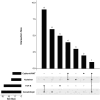This is a preprint.
Red meat intake interacts with a TGF-β-pathway-based polygenic risk score to impact colorectal cancer risk: Application of a novel approach for polygenic risk score construction
- PMID: 40568668
- PMCID: PMC12191096
- DOI: 10.1101/2025.06.13.25329599
Red meat intake interacts with a TGF-β-pathway-based polygenic risk score to impact colorectal cancer risk: Application of a novel approach for polygenic risk score construction
Abstract
Background: High intake of red and/or processed meat are established colorectal cancer (CRC) risk factors. Genome-wide association studies (GWAS) have reported 204 variants (G) associated with CRC risk. We used functional annotation data to identify subsets of variants within known pathways and constructed pathway-based Polygenic Risk Scores (pPRS) to model pPRS x environment (E) interactions.
Methods: A pooled sample of 30,812 cases and 40,504 CRC controls of European ancestry from 27 studies were analyzed. Quantiles for red and processed meat intake were constructed. The 204 GWAS variants were annotated to genes with AnnoQ and assessed for overrepresentation in PANTHER-reported pathways. pPRS's were constructed from significantly overrepresented pathways. Covariate-adjusted logistic regression models evaluated pPRSxE interactions with red or processed meat intake in relation to CRC risk.
Results: A total of 30 variants were overrepresented in four pathways: Alzheimer disease-presenilin, Cadherin/WNT-signaling, Gonadotropin-releasing hormone receptor, and TGF-β signaling. We found a significant interaction between TGF-β-pPRS and red meat intake (p = 0.003). When variants in the TGF-β pathway were assessed, significant interactions with red meat for rs2337113 (intron SMAD7 gene, Chr18), and rs2208603 (intergenic region BMP5, Chr6) (p = 0.013 & 0.011, respectively) were observed. We did not find evidence of pPRS x red meat interactions for other pathways or with processed meat.
Conclusions: This pathway-based interaction analysis revealed a significant interaction between variants in the TGF-β pathway and red meat consumption that impacts CRC risk.
Impact: These findings shed light into the possible mechanistic link between CRC risk and red meat consumption.
Conflict of interest statement
C.M.U. has as cancer center director oversight over research funded by several pharmaceutical companies but has not received funding directly herself.
Figures



References
-
- Sung H, Ferlay J, Siegel RL, Laversanne M, Soerjomataram I, Jemal A, et al. Global Cancer Statistics 2020: GLOBOCAN Estimates of Incidence and Mortality Worldwide for 36 Cancers in 185 Countries. CA Cancer J Clin. 2021. May;71(3):209–49. - PubMed
-
- Morgan E, Arnold M, Gini A, Lorenzoni V, Cabasag CJ, Laversanne M, et al. Global burden of colorectal cancer in 2020 and 2040: incidence and mortality estimates from GLOBOCAN. Gut. 2023. Feb;72(2):338–44. - PubMed
-
- Petimar J, Smith-Warner SA, Rosner B, Chan AT, Giovannucci EL, Tabung FK. Adherence to The World Cancer Research Fund/American Institute for Cancer Research 2018 Recommendations for Cancer Prevention and Risk of Colorectal Cancer. Cancer Epidemiol Biomark Prev Publ Am Assoc Cancer Res Cosponsored Am Soc Prev Oncol. 2019. Sep;28(9):1469–79. - PMC - PubMed
Publication types
Grants and funding
- U01 HG004438/HG/NHGRI NIH HHS/United States
- U01 HG004446/HG/NHGRI NIH HHS/United States
- K05 CA154337/CA/NCI NIH HHS/United States
- P30 DK034987/DK/NIDDK NIH HHS/United States
- U01 CA164930/CA/NCI NIH HHS/United States
- R01 CA066635/CA/NCI NIH HHS/United States
- U01 CA167551/CA/NCI NIH HHS/United States
- HHSN268201600004C/HL/NHLBI NIH HHS/United States
- R01 CA042182/CA/NCI NIH HHS/United States
- UM1 CA167552/CA/NCI NIH HHS/United States
- U01 CA122839/CA/NCI NIH HHS/United States
- R01 CA059045/CA/NCI NIH HHS/United States
- R01 CA197350/CA/NCI NIH HHS/United States
- R35 CA197735/CA/NCI NIH HHS/United States
- U2C CA252971/CA/NCI NIH HHS/United States
- U10 CA037429/CA/NCI NIH HHS/United States
- HHSN268201600002C/HL/NHLBI NIH HHS/United States
- U54 CA233465/CA/NCI NIH HHS/United States
- P01 CA087969/CA/NCI NIH HHS/United States
- P30 CA015704/CA/NCI NIH HHS/United States
- HHSN268201600018C/HL/NHLBI NIH HHS/United States
- P30 CA006973/CA/NCI NIH HHS/United States
- Z01 CP010200/ImNIH/Intramural NIH HHS/United States
- P01 CA055075/CA/NCI NIH HHS/United States
- S10 OD028685/OD/NIH HHS/United States
- R01 CA151993/CA/NCI NIH HHS/United States
- U01 CA167552/CA/NCI NIH HHS/United States
- R01 CA048998/CA/NCI NIH HHS/United States
- U01 CA137088/CA/NCI NIH HHS/United States
- R01 CA137178/CA/NCI NIH HHS/United States
- HHSN268201200008C/HL/NHLBI NIH HHS/United States
- R01 CA242218/CA/NCI NIH HHS/United States
- P30 CA014089/CA/NCI NIH HHS/United States
- R01 CA081488/CA/NCI NIH HHS/United States
- R01 CA143237/CA/NCI NIH HHS/United States
- HHSN268201600003C/HL/NHLBI NIH HHS/United States
- R01 CA201407/CA/NCI NIH HHS/United States
- R01 CA063464/CA/NCI NIH HHS/United States
- P01 CA033619/CA/NCI NIH HHS/United States
- U01 CA086308/CA/NCI NIH HHS/United States
- UM1 CA186107/CA/NCI NIH HHS/United States
- R01 CA060987/CA/NCI NIH HHS/United States
- R01 CA136726/CA/NCI NIH HHS/United States
- HHSN268201600001C/HL/NHLBI NIH HHS/United States
- UM1 CA182883/CA/NCI NIH HHS/United States
- HHSN268201200008I/HL/NHLBI NIH HHS/United States
- R37 CA054281/CA/NCI NIH HHS/United States
- U19 CA148107/CA/NCI NIH HHS/United States
- U01 AG018033/AG/NIA NIH HHS/United States
LinkOut - more resources
Full Text Sources
